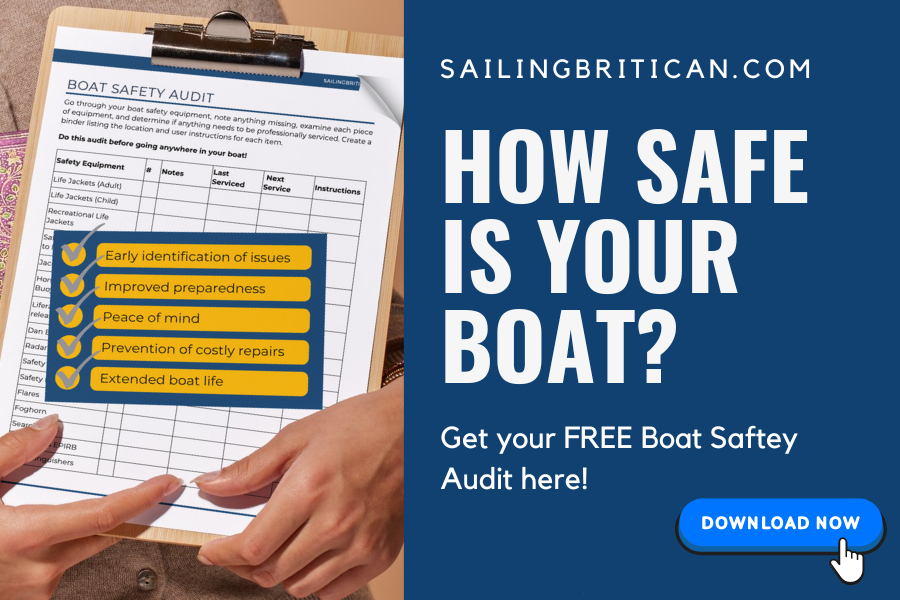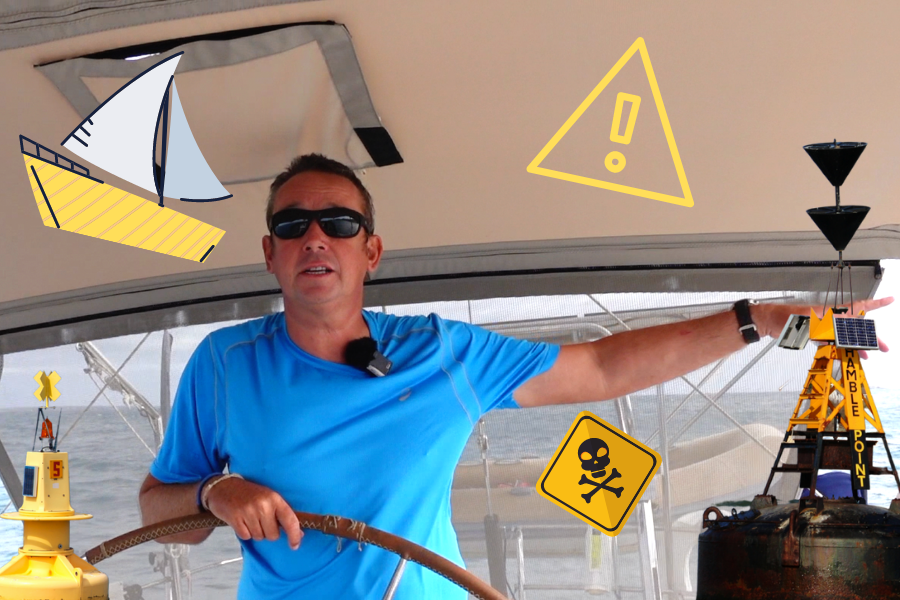It’s important to understand the sailing basics and the boat rules of the road—avoiding collisions with anything that might damage your boat. What do you look at before you leave an anchorage or port? Once you’re underway and sailing, how soon do you pay attention to known obstacles, like reefs and channel markers?
What about unknowns like anchored or moving boats? How do you know if a boat is on a collision course with you? Answers to all these sailing basics questions are addressed and demonstrated in this sailing video.
Sailing Basics – Boat Rules
Before leaving an anchorage, we review our iPad charts, local pilot books, and plotter. We look for obstacles between where we are and where we’re going. An obstacle might be a cardinal marker or a shallow patch of water—anything that could damage our boat.
Once we know the obstacles, we keep a lookout for them until we pass. While earmarking known obstacles, we also watch for unknown dangers like anchored and moving boats. As soon as we see a moving boat, we determine if it’s heading away or towards us. If it’s coming toward us, we keep watching the boat to determine if we’re on a collision course or not.
While sailing or motoring around busy areas, we are constantly watching and monitoring our surroundings.
It’s good practice to assume that all the other boaters around you don’t know what they’re doing. Sure, there are rules to determine who has right of way but so many boaters don’t really understand the rules. If you keep an eye on the boats around you and work to get out of their way, you’ll save yourself quite a bit of stress.
As my husband, Simon, often says, ‘Assume that the person on the boat approaching you is sleeping and just get out of his or her way.’ Over the course of eight years of sailing, we’ve passed many boats where no one is in the cockpit or the helmsperson is asleep in the cockpit.
When it comes to who has the right of way, no one has the right of way. A collision needs to be avoided at all costs.

FREE Boat Safety Audit: Speaking of boat safety, make sure you create the safest boating enviornment you can. Get our FREE Boat Safety Audit now.
So, you’ve got your sea legs (sort of), and you’re ready to take on the open water. That’s fantastic! But before you cast off,let’s chat about the 10 essential boat rules. Trust me, these aren’t just some dusty regulations; they’re your guide to safe and smooth sailing.
- Department of Homeland Security (Author)
- English (Publication Language)
- 200 Pages – 04/28/2023 (Publication Date) – Independently published (Publisher)
Top 10 Boat Rules
- Keep a Sharp Lookout: This might seem obvious, but you’d be surprised how many folks zone out. Always be aware of your surroundings, scan the horizon for other vessels, and anticipate their movements. Remember, your eyes are your best defense against collisions.
- Know Your Priorities: Not all boats are created equal regarding right of way. Generally, vessels restricted in their ability to maneuver (like fishing boats with gear deployed) get priority, followed by sailboats and then powerboats. But there are exceptions, so brush up on the specifics!
- Starboard Over Port: If two sailboats are approaching each other, the one on the starboard tack (wind coming over the right side) has the right of way. The port tack boat must give way.
- Windward Gives Way: If two sailboats are on the same tack, the windward (upwind) boat must give way to the leeward (downwind) boat. Think of it like letting the “underdog” have a bit more space.
- Overtaking Requires Care: If you’re overtaking another boat, it’s your responsibility to stay clear and avoid getting too close. Give them a wide berth and make your intentions clear. Remember, a friendly wave never hurts!
- Power to Sail: Powerboats generally give way to sailboats unless the sailboat is overtaking. Think of it as the motorized vessel doing a courtesy to its wind-powered counterpart.
- Use Common Sense: Sometimes things get tricky even with all the rules. If you’re unsure, err on caution and give way. It’s better to be safe than sorry (or sunk).
- Sound Signals: Horns aren’t just for celebrations; they’re crucial for communication on the sea. Learn the different sound signals for maneuvering and warning other vessels.
- Lights at Night: Navigating at night requires a whole new set of rules. Make sure your navigation lights are working properly, and understand what the different light configurations on other boats mean.
- Local Regulations: Every waterway might have its own specific rules. Before you set sail, familiarize yourself with any local regulations that might apply.
Bonus Tip: Even if you’re in the right, always try to avoid a collision. A little flexibility and understanding can go a long way in keeping everyone safe and happy on the water.
Any thoughts, feedback, or stories about boating collision regulations or boating right of way rules? Please leave them below.


Thanks!
Hi Simon,
you explain it quite well. However, if people don’t know this (right of way, avoiding collision, how to use AIS, and so on) they have no business skippering a boat. They should stay ashore.
I agree…but the reality is that there are many boaters out there that don’t know very much. Thanks for commenting Erik.
There is no such thing as a “right of way” if you are not racing.